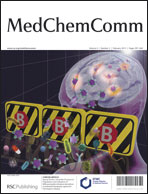*
Corresponding authors
a
Medicinal Chemistry, CNSP iMed Science, AstraZeneca R&D, Innovative Medicines, SE-15185 Södertälje, Sweden
E-mail:
ulrikayngve@telia.com
Tel: +46-70-3095769
b
DMPK, CNSP iMed Science, AstraZeneca R&D, Innovative Medicines, SE-15185 Södertälje, Sweden
c
Neuroscience, CNSP iMed Science, AstraZeneca R&D, Innovative Medicines, SE-15185 Södertälje, Sweden
d
Science for Life Laboratory, Division of Translational Medicine and Chemical Biology, Department of Medical Biochemistry and Biophysics, Karolinska Institutet, Stockholm, Sweden
e
CNSP iMed Project Management, AstraZeneca R&D, Innovative Medicines, SE-15185 Södertälje, Sweden
f
Organic Pharmaceutical Chemistry, Department of Medicinal Chemistry, Uppsala Biomedical Centre, Uppsala University, Box 574, SE-751 23 Uppsala, Sweden
g
School of Pharmacy and Pharmacology, University of KwaZulu-Natal, Westville Campus, Private Bag X54001, Durban 4000, South Africa


 Please wait while we load your content...
Please wait while we load your content...